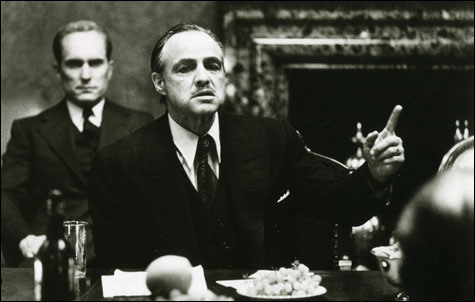Gordon Willis at the Harvard Film Archive
By STEVE VINEBERG | November 18, 2009

THE GODFATHER Good luck trying to read Marlon Brando’s eyes. |
| “Gordon Willis: The Man Who Shot The Godfather” | Harvard Film Archive: November 20-30 |
Gordon Willis, the master cinematographer to whom the Harvard Film Archive pays tribute in a seven-film retrospective beginning this Friday, broke the rules about how to shoot a movie star when he refused to light Marlon Brando's eyes in The Godfather. His aim, he explains in the 1992 documentary Visions of Light, was to maintain Don Corleone's mystery, not to subvert Hollywood-style lighting. But he came into his own as an artist at a time — the Vietnam War era — when movies, influenced equally by the counterculture and by the infusion of innovative European pictures, were looking for alternative and generally darker visions. Moreover, he became a director of photography on the East Coast, far from the traditions associated with Hollywood soundstages.Willis, who received his training in a film unit during the Korean War, didn't graduate to DP until 1970. He made four movies that year alone, among them Irvin Kershner's Loving and Hal Ashby's debut picture, THE LANDLORD, which closes the HFA series on November 30. The Landlord is an exuberant, sharp-witted piece about a white aristocrat named Elgar (Beau Bridges) who buys an apartment in a Brooklyn ghetto with the intention of tearing it down but instead finds himself being drawn into the lives of his tenants. And it's hard to believe this movie could have been turned out in the first year of any cinematographer's career. Willis gives it a warm, intimate feel, contrasting the summery sequences at Elgar's parents' Long Island estate, where there's a stylized excess of space and the sun drifts in through huge windows in every room of the house, with the dark, crowded Park Slope scenes, where the lives of the men and women in the building spill rudely into the streets. Willis isn't trying to tell us that the Brooklyn apartment house is claustrophobic — his point is that it's layered with humanity. Just by looking at the textured lighting, you understand what pulls Elgar in.
His fellow photographer Conrad Hall dubbed Willis "the prince of darkness" ("He has made an art of underexposure," Hall offers in Visions of Light), but that moniker seems better suited to the work he did on THE GODFATHER: PART II (November 29) than to THE GODFATHER (November 28). It's true that the famous opening shot of the earlier movie shows the face of the undertaker Bonasera (Salvatore Corsitto) against a black background; the setting comes slowly into focus as Francis Coppola tracks back, and it takes a while for us to register the details — a pair of doorknobs, a coffee-table top, the panels in Vito Corleone's study door. But though the film offers some memorable nocturnal images — like that of Sterling Hayden's Captain McCluskey, shadows dancing across his face, as he slugs Al Pacino's Michael Corleone outside the hospital where Michael's father is recovering from an attempt on his life — much of it is shot in the open, in wide, airy spaces. Coppola's work is firmly in the tradition of Jean Renoir and William Wyler; you can't imagine The Godfather without the use of the deep-focus lens. To pick the most striking example, the long sequence at the wedding of Don Corleone's daughter Connie (Talia Shire) — which alternates glimpses of the party with interludes where the godfather is shut up in his study with one petitioner after another — has an enveloping, sensuous depth. The combination of the meticulous period re-creations (the setting is the mid '40s) with Coppola's dense, layered staging and the way Willis lights the space makes it the least remote of all evocations of an American past.
 Related
Related:
In the realm of Oshima, Sweet smell of skill, True voices, More 
- In the realm of Oshima
The HFA looks back at the bad boy of Japanese cinema
- Sweet smell of skill
Alexander Mackendrick, who's the subject of a tribute at the Harvard Film Archive this weekend, is a somewhat mysterious figure in movie history.
- True voices
When I first checked out Travis Sullivan's Björkestra live, it wasn't to see the singer. But live, the Björkestra (at the Regattabar last October) turned my expectations upside down.
- All's well that is Welles
Some of the best of the last Orson Welles flicks at the HFA
- William Friedkin at the Harvard Film Archive
However we may still praise, and therefore bury, the American New Wave, we do still run the genuine risk of slipping down the wormhole slicked by present-moment techno obsessions and amnesiac entertainment-media narcissism.
- Review: The Godfather II
If adapting the Godfather series means stripping it of subtext and amplifying the thuggery, that may be the greatest imaginable indictment of video games as a medium.
- Review: Dust
German documentarian Hartmut Bitomsky likes to make movies about how things are put together and how they come apart.
- Hope city
Filmmaker looks at life Under the Bridge
- Scholarship gigs
When in 1999 Björn Wennås moved from Sweden to Boston to study jazz guitar, he hardly imagined that he'd one day be playing in an ensemble that specializes in Italian folk music of the 12th to 19th centuries.
- Cheese Danish
Hamlet variations we'd like to see
- War zones
The party’s over. Time for the lessons to begin.
- Less

 Topics
Topics:
Features
, Celebrity News, Entertainment, Sterling Hayden, More  , Celebrity News, Entertainment, Sterling Hayden, THE GODFATHER, Harvard Film Archive, Beau Bridges, The Godfather II, Harvard University, Manhattan, Movie Stars, Less
, Celebrity News, Entertainment, Sterling Hayden, THE GODFATHER, Harvard Film Archive, Beau Bridges, The Godfather II, Harvard University, Manhattan, Movie Stars, Less 